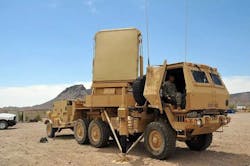Lockheed Martin to build AN/TPQ-53 counter-fire radar to protect against artillery and uncrewed aircraft
ABERDEEN PROVING GROUND, Md. – Radar experts at Lockheed Martin Corp. are moving to full-scale production of the company's AN/TPQ-53 counter-fire radar to detect, classify, track, and pinpoint enemy drones and incoming artillery shells without posing a risk to nearby aircraft and military forces.
Officials of the U.S. Army Contracting Command at Aberdeen Proving Ground, Md., announced a $3.3 billion five-year contract last week to the Lockheed Martin Rotary and Mission Systems segment in Liverpool, N.Y., for AN/TPQ-53 radar systems for U.S. allies.
The so-called Q-53 is a solid-state phased array radar that detects, classifies, tracks, and determines the location of enemy indirect fire weapons like rockets, artillery shells, and mortars in either 360- or 90-degree modes. This system is replacing the aging U.S. Army AN/TPQ-36 and AN/TPQ-37 medium-range radars.
The contract includes spare parts and services. The AN/TPQ-53 radar is the U.S. Army's standard forward-deployed system for long-range surveillance and tracking radar against rockets, artillery, and mortar threats for brigade combat teams. Lockheed Martin builds the Q-53 radar in Liverpool and Owego, N.Y.; Moorestown, N.J.; and Clearwater, Fla.
In recent years Lockheed Martin has upgraded the radar system to enhance its reliability against enemy drones and other uncrewed aircraft, and integrate an off-the-shelf identification-friend-or-foe (IFF) subsystem to the radar.
Since its initial construction, Lockheed Martin also has upgraded electronic components in the AN/TPQ-53 to increase its accuracy in high radar clutter, decrease its false location rate, as well as improve its probability of location and probability of correct classification.
The Q-53 radar is deployed on an Army 5-ton FMTV truck, and can go into battle with heavy, medium, and light forces. A second tactical truck carries a control shelter, backup power generator, and two additional soldiers to operate the system. Lockheed Martin started developing the Q-53 counter-fire radar in 2007.
The AN/TPQ-53 is designed to detect the firing points of enemy mortars, artillery shells, and rockets with sufficient accuracy to enable counter-fire artillery to destroy the enemy launcher with one shot.
The Q-53 is deployable as part of the Counter-Rocket Artillery and Mortar (C-RAM) system of systems (SoS) to provide a sense and warn capability for deployed U.S. and allied forces. The system is small enough to move aboard C-130 and C-17 aircraft.
On this contract Lockheed Martin will do the work at locations and funding will be determined with each order, and should be finished by March 2027. For more information contact Lockheed Martin Rotary and Mission Systems online at www.lockheedmartin.com.
About the Author
John Keller
Editor-in-Chief
John Keller is the Editor-in-Chief, Military & Aerospace Electronics Magazine--provides extensive coverage and analysis of enabling electronics and optoelectronic technologies in military, space and commercial aviation applications. John has been a member of the Military & Aerospace Electronics staff since 1989 and chief editor since 1995.
